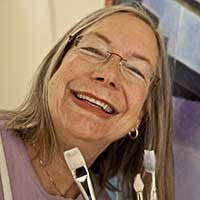
So here's the deal. I tweet. Yes I do. It's really quite addictive. I follow quite a few artists who also tweet. Via these contacts, I got involved in a Mail Art project. 33 artists from the USA, Australia, UK and Canada are doing a postcard exchange. Everyone creates 32 unique postcards to send out. And everyone should receive 32 unique postcards from people all over the world.
I signed up, not quite realizing what a time commitment it would be. Of course, creating an involved postcard process added to the time. For some reason, doing something with thin plexiglass stuck in my head. So I ordered some from Dick Blick.
Step 1: cutting the plexiglass to postcard size. I did this by carefully measuring and then scoring each piece with a mat knife. The excess was snapped off with a pair of pliers. When lucky, there was a clean edge, when not so lucky, it was ragged and needed more snapping. Then I used a file to round the corners, and smooth the edges so they wouldn't be sharp.

This is the back of one of the cards. Didn't realize that this side didn't need to be embellished, too. So I did something unique on the back of each one I sent. By the way, this card went to Mark Phillip Venema, Art_News, the Canadian artists who organized the project.
Anyway, on to
Step 2: Measured 11 spots on the top and bottom (long sides) of the plexi, and drilled small holes.

Step 3: Cut backing paper from scraps of Strathmore drawing paper, to postcard size. I did this assembly line style, cutting a dozen at a time.
Step 4: I worked in Photoshop to resize images of my paintings, starting with the Nooks & Crannies series. There are 12 of these. I printed 6 per sheet of paper on my trusty Canon printer.
Step 5: I cut each sheet into pieces, leaving a 1/2" border around each print.
Step 6: I looked through piles of paper scraps, looking for just the right color/texture/pattern to go with the particular image.
Step 7: I cut a window into the colored paper, leaving a 1/4" border. Then I centered the print on the white Strathmore and glued it down.
Step 8: Next, I glued the colored paper onto the Strathmore, trying to get the window straight around the image. This was tricky.

Step 9: I stacked the backing paper w/ image on top of the plexiglass over a piece of foam core. and used an awl to punch holes through the backing, lining up with the holes in the plexi.
Step 10: I used colored phone wires I was given years ago and have been lugging around from place to place, to stitch the front to the back.

Step 11: I flipped it over, addressed it, and added a message and some decoration.
Step 12: When I finished 6 of them, I took them to the post office to mail off.

I really intended to just do 12 this way, and then figure out some other creative thing to do for the remaining 20 postcards. But.... it really took a long time to figure out how to create what you see. Each step was a learning process. So, I decided to continue in the same vein.
What you see below is the image of a painting not from the Nooks and Crannies series.

I ended up sending out 32 postcards with 32 tiny images of 32 of my paintings. The whole process took about a full week of long days to make.
So far I've received 5 postcards from the #mailart group. Every day it's exciting to go to the post office, open our box and see what's waiting for me.
Now, I really really need to switch gears and get back to painting!










